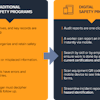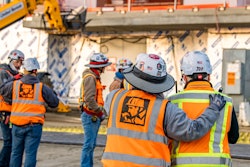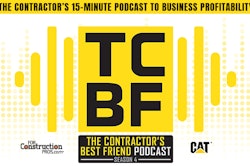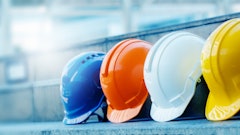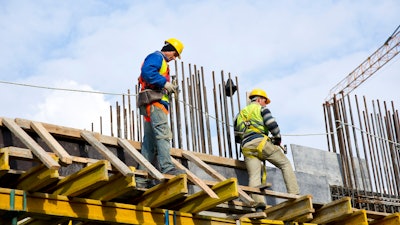
Working in construction is an inherently hazardous activity, with a high risk of accidents on-site, as well as increasingly complex health and safety risks and hazards off-site. This is why knowing the best ways to prevent construction site hazards will put you and your building sites in the optimal position to continue to attract the best workers.
Injury, long-term damage, illnesses and mental health issues are some of the main negative outcomes that construction site managers or employers need to prevent. This is especially crucial given that, on average, two construction workers die of work-related injuries every day in the United States.
If this number sounds staggering, consider as well that one in five workplace fatalities are construction-related. Understanding the hazards, their consequences and the measures you can take to create a better working environment on construction sites makes sense for you and your workers’ well-being, and for your business.
Construction Work Hazards and Risks
The construction work site presents numerous risks for employees, the first and foremost being the risk of falling. According to data from the Occupational Safety and Health Administration (OSHA) and the Census of Fatal Occupational Injuries prepared by the U.S. Bureau of Labor Statistics, the top reasons for injuries at work in 2019 included:
- Transportation incidents, which increased the most in 2019 since reporting of this caliber started in 2011.
- Falls, slips and trips increased by 11% in 2019.
- Exposure to harmful substances or environments, which eventually led to the death of 642 workers in 2019, the highest figure since this census began.
- Fatalities due to fires and explosions, although decreasing.
- Unintentional overdoses due to nonmedical use of drugs or alcohol, increasing for the seventh consecutive year.
While the first four categories above are physical hazards, construction employers shouldn’t underestimate the fifth risk, which points to the rise of mental health issues in the workplace in a construction environment.
The worrying aspect of this is, of course, the fact that all but one type of fatal accidents increased in the most recent year of reporting. Despite what we may perceive to be an overall increase in awareness and regulation in all industries when it comes to workers’ health and well-being, the numbers point to the opposite.
In addition to the top causes of fatalities listed above, it is also worth highlighting several other potential risks in construction, which can lead to harm or injury:
- Lack of communication/unclear training.
- Objects that are likely to strike victims, such as falling/flying objects, vehicles, or masonry walls, leading to 10.3% of accidents.
- Electrocution, commonly due to contact with power lines or improper use of equipment, potentially linked to improper training.
- Being caught between objects because of unsafe access/egress, unsafe spoil-pile placement, failure to inspect trench and protective systems, or no protective systems in place.
Consequences of Construction Hazards
Knowing the risks and hazards present in a construction environment doesn’t tell the full story from the human or economic point of view. In fact, beyond deaths or physical or mental harm, there is a high toll to pay for businesses that disregard the potential harmful impact of on- and off-site hazards.
The immediate consequence of accidents in the construction industry is financial. As of 2002, the total costs of fatal and non-fatal injuries were estimated at $11.5 billion, making up 15% of the costs for all private industry.
With an average cost of $27,000 per injury, this is certainly a massive consequence of hazards that go unchecked in construction. It is also important to note that the average cost across all industries for an injury is only $15,000 by comparison, making the construction industry a much costlier sector when injuries occur.
Moreover, employers can incur significant fines if found to be in violation of OSHA standards. Excluding de minimis violations, where employers are simply verbally informed of where they are lacking, fines for other violations start from $13,494 and can go up to 10 times that amount for repeated violations.
Another consequence of unsafe or stressful working conditions is more subtle: mental health repercussions from stress, depression, or anxiety are on the rise in the construction industry. Combined with any other type of illness causing employees to miss work, they also have the potential to snowball into significant losses for construction projects.
RELATED:
- 18 Tips to Stay Cool on the Jobsite in the Summer Heat
- 6 Scientifically Proven Hacks to Stay Cool While Working in Heat
- Top 10 OSHA Violations of 2020
- The Contractor's Best Friend Podcast: Safety Tips for the New Normal
Finally, consequences of hazards and risks should not be evaluated solely on the basis for loss to the employer or construction site manager. For workers, beyond the evident impact on personal health and well-being, the impact of an accident can be monumental and even lead to the loss of livelihood of an entire family.
This is especially true in minority communities, where often the main breadwinner is the injured worker. In addition to the loss of earnings, medical costs can be prohibitive in the United States and can have huge impacts depending on the employee’s medical coverage and severity of injury or illness.
 Beyond deaths or physical or mental harm, there is a high toll to pay for businesses that disregard the potential harmful impact of on- and off-site hazards.freepik
Beyond deaths or physical or mental harm, there is a high toll to pay for businesses that disregard the potential harmful impact of on- and off-site hazards.freepik
How to Prevent Accidents and Keep Workers Safe
In the United States, OSHA regulates the employer’s responsibilities for construction workers. Beyond the legal requirement, there is also a moral duty of care towards employees, which extends to their mental well-being that in turn can benefit the business and the workers equally.
Follow all OSHA guidelines
From a regulation perspective, OSHA imposes regulations for employers to provide a safe workplace. This includes:
- Ensure that construction sites are free of recognized hazards as much as possible.
- Comply with all standards, rules and regulations issued under the OSH Act.
- Examine working conditions to ensure they comply with OSHA standards.
- Provide safe tools and equipment and maintain them to the best possible standard.
- Ensure accurate warnings are in place to highlight potential hazards to workers, including color codes, posters, or labels).
- Have in place clear operating procedures which are updated as required and communicated clearly to employees.
- Ensure that training is given before any work is done on site, and that training is provided in a language and vocabulary that workers understand, which is especially important given the high percentage of immigrant workers in the construction industry.
- Have a hazard communication program if employees work with hazardous chemicals.
- Provide medical exams and training.
- This is not an exhaustive practical list, and more information can be found on the OSHA guidance website.
Protect Workers’ Mental Health
Beyond the OSHA employer guidelines listed above, there is the growing importance of ensuring health and well-being are looked after in the realm of mental illness. Employers have a moral duty to ensure working environments are as stress-free as possible, free of discrimination and abuse of all kinds.
Maintain Clear and Transparent Communication
In addition to clear and comprehensive training practices, employees in the construction industry should remain transparent and honest about hazards and incident reporting.
Any accidents or injuries should be discussed openly with employees to ensure all parties take away lessons from what has happened. These discussions can also lead to an information exchange that can ensure better practices in the future.
While the immediate consequences of construction site accidents are not always visible, there are numerous hazards and risks that will show an impact in the longer term, as well.
These include not just mental health and well-being issues for construction workers, but also financial repercussions on business owners and on workers, as well as moral obligations towards these workers.
This is why all construction site managers should strictly observe OSHA guidelines, followed by adherence to clear and transparent training and communication practices and respect for workers’ mental well-being.
Written by Adrian Abad, marketing manager at Vatix.
